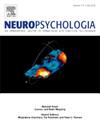使用快速周期性视觉刺激测量隐式线方向辨别。
IF 2
3区 心理学
Q3 BEHAVIORAL SCIENCES
引用次数: 0
摘要
快速周期视觉刺激古怪范式(fpvs -odd - ball)是区分两类频率标记刺激(标准和古怪)的脑电图(EEG)标记。在这里,我们使用fpvs -odd来探测低水平的视觉功能,以期在未来将其作为视觉感知认知障碍的敏感诊断标志物。30名参与者(21(±5)岁,7名男性)完成了5个fpvs -odd - ball条件,隐性测量了他们从标准垂直线(1°,5°,10°,30°,80°)和等概率控制条件中区分odd - ball线方向的能力。24名参与者(24(±5)岁,5名男性)在一个月后完成了重新测试。经过100秒的记录,观察到在5°及以上的线上,古怪呈现频率(标准和古怪刺激之间的区分神经信号)的活动。随着古怪线偏离垂直线的程度增加,这种古怪反应的强度也随之增加。为了证明个体参与者的一致性,30/30的参与者对30°偏差的反应是奇怪的,29/30的参与者对80°偏差的反应是奇怪的。在较大的偏差下,古怪的反应在会话之间是高度可靠的,使用类内相关性来测量。总体而言,本研究表明,fpvs -odd - ball可以持续可靠地测量个体参与者的线取向歧视。在认知健康的人群中,古怪反应的一致性和可靠性可以为临床组的表现提供一个强有力的基线,可以比较,指导神经认知评估。本文章由计算机程序翻译,如有差异,请以英文原文为准。
Measuring implicit line orientation discrimination using fast periodic visual stimulation
The fast periodic visual stimulation oddball paradigm (FPVS-oddball) is an electroencephalography (EEG) marker of discrimination between two classes of frequency tagged stimuli (standards and oddballs). Here, we probe low-level visual function using FPVS-oddball, with a view to its future use as a sensitive diagnostic marker of visuoperceptual cognitive impairment. Thirty participants (21 (±5) years, 7 males) completed five FPVS-oddball conditions that implicitly measured their ability to discriminate an oddball line orientation (1°,5°,10°,30°,80°), from a standard vertical line, as well as an equiprobable control condition. Twenty-four participants (24 (±5) years, 5 males) completed a retest session around one month later. Following 100s of recording, activity at the oddball presentation frequency, a neural signal of discrimination between standard and oddball stimuli, was observed in response to lines of 5° and above. The magnitude of this oddball response increased as oddball lines deviated more from vertical. Demonstrating consistency in individual participants, oddball responses were present in 30/30 participants in response to a deviation of 30° and 29/30 in response to a deviation of 80°. At larger deviations, oddball responses were highly reliable between sessions, measured using intraclass correlations. Overall, this study showed that FPVS-oddball can consistently and reliably measure line orientation discrimination in individual participants. The consistency and reliability of oddball responses in the cognitively healthy, could provide a strong baseline that clinical group's performance could be compared to, guiding neurocognitive assessment.
求助全文
通过发布文献求助,成功后即可免费获取论文全文。
去求助
来源期刊

Neuropsychologia
医学-行为科学
CiteScore
5.10
自引率
3.80%
发文量
228
审稿时长
4 months
期刊介绍:
Neuropsychologia is an international interdisciplinary journal devoted to experimental and theoretical contributions that advance understanding of human cognition and behavior from a neuroscience perspective. The journal will consider for publication studies that link brain function with cognitive processes, including attention and awareness, action and motor control, executive functions and cognitive control, memory, language, and emotion and social cognition.
 求助内容:
求助内容: 应助结果提醒方式:
应助结果提醒方式:


